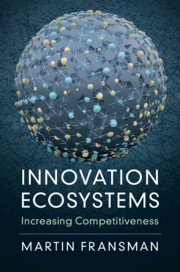Book contents
- Innovation Ecosystems
- Innovation Ecosystems
- Copyright page
- Dedication
- Contents
- Preface
- 1 Introduction
- 2 Contextualising Innovation
- 3 ‘National Innovation Systems’, ‘Business Ecosystems’, and ‘Innovation Ecosystems’
- 4 The ICT Innovation Ecosystem*
- 5 Interview with Martin Fransman on Innovation Ecosystems*
- 6 How Does Innovation Happen?
- 7 Who Makes Innovation Happen? Is the Entrepreneur Becoming Obsolete?
- 8 Innovation Ecosystems and Financial Markets*
- 9 Innovation Ecosystems, New Waves of Industrialisation, and the Implications for China*
- 10 Keynes’s General Theory of Employment, Interest, Money, and Innovation*
- 11 Conclusions
- Bibliography
- Index
- References
Bibliography
Published online by Cambridge University Press: 24 September 2018
- Innovation Ecosystems
- Innovation Ecosystems
- Copyright page
- Dedication
- Contents
- Preface
- 1 Introduction
- 2 Contextualising Innovation
- 3 ‘National Innovation Systems’, ‘Business Ecosystems’, and ‘Innovation Ecosystems’
- 4 The ICT Innovation Ecosystem*
- 5 Interview with Martin Fransman on Innovation Ecosystems*
- 6 How Does Innovation Happen?
- 7 Who Makes Innovation Happen? Is the Entrepreneur Becoming Obsolete?
- 8 Innovation Ecosystems and Financial Markets*
- 9 Innovation Ecosystems, New Waves of Industrialisation, and the Implications for China*
- 10 Keynes’s General Theory of Employment, Interest, Money, and Innovation*
- 11 Conclusions
- Bibliography
- Index
- References
- Type
- Chapter
- Information
- Innovation EcosystemsIncreasing Competitiveness, pp. 316 - 324Publisher: Cambridge University PressPrint publication year: 2018



